Hack6.Troubleshoot Your PSP
Hack 6. Troubleshoot Your PSP
What to do when the PSP freezes, a game consistently skips, a game won't load, or if a memory stick isn't showing up. You're stuck. Your PSP isn't acting the way it once did, and you're not sure why. Here are some common problems you may encounter, along with a few ideas for troubleshooting those problems. 1.7.1. UMD Game/Movie Won't LoadThis is one of the most common problems you will run into with your PSP. You've just placed your favorite UMD game in, but the PSP doesn't seem to recognize that it is there. Here are some things to do. 1.7.1.1. Check for a clean disk.First, simply remove the disk and put it back in. Maybe it wasn't firmly seated the first time you tried. If that does nothing, remove the disk again and make sure that it is clean. If you've been out in the summer heat and have come indoors to some cool air-conditioning, check for condensation. If that's the problem, play another game while you wait for the moisture on the disk to dissipate. If there are any particles or dust on the disk, try blowing these particles off. Consider using a compressed air can to blow particles from the inside of the disk; you can find these cans in any computer or electronics store. If you have smudged the disk via the little open window compartment on the UMD disk, then you are going to need to wipe that smudge off. Try to rotate the disk by pushing in the middle with your index finger and turning your finger, as shown in Figure 1-14. Do this until the smudged part of the disk is lined up with the open portion. Now, clean the smudge just like you would clean a CD/DVD or a camera lens. Breathe lightly on the disk to get a slight fog on it and then use a soft non-abrasive cloth (see Figure 1-15) to gently wipe from the inner ring of the disk outward. If the smudge extends to other parts of the disk, continue to rotate the disk, working section by section until it is fully clean. Figure 1-14. Push your index finger into the spindle of the disk and turn gently to rotate the disk for cleaning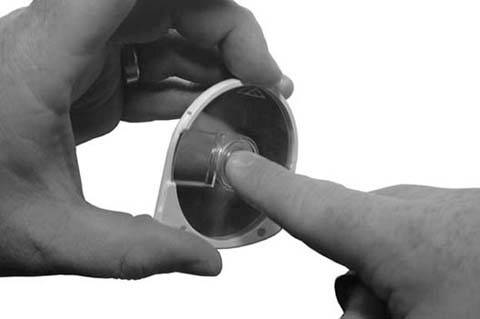 Figure 1-15. Using a soft cloth, gently clean the disk by going from the middle to the outer edge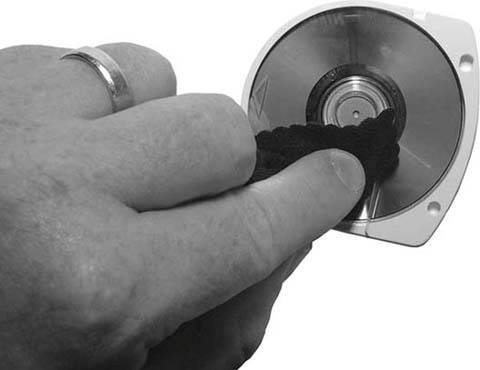
1.7.1.2. Check the clear plastic cover on the disk.Another thing that can happen with a UMD disk that has been squished inside a bag is that the clear plastic disk cover on the top of the game can snap loose from the white plastic frame of the disk (see Figure 1-16). The clear cover then exerts pressure on the back of the disk, preventing it from spinning up when the UMD is put inside the PSP. If this happens, simply hold the UMD disk on either side of the white plastic casing, and then take your index finger and push gently up against the middle of the disk until you hear a slight clicking noise (see Figure 1-17). If all went well, you have successfully popped the clear plastic cover back into place and the disk will spin up properly the next time you insert it in the PSP. Figure 1-16. Check to make sure that the plastic cover on your UMD is lined up perfectly with the white plastic casing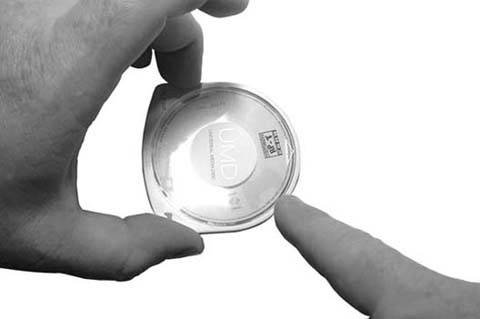 Figure 1-17. Press gently but firmly against the bottom middle of the UMD disk to pop the clear cover back into place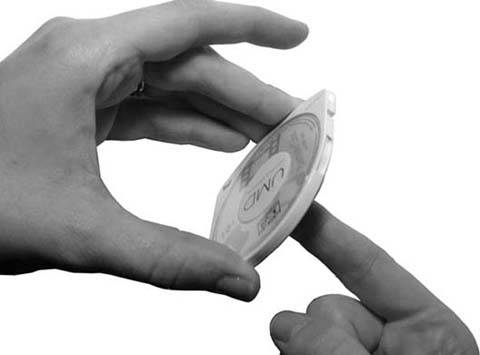 1.7.1.3. Is it a bad disk?If none of these solutions work, try putting another UMD disk in your PSP to see whether it works. If it does, the good news is that your PSP works fine. The bad news is that game or movie is dead. Time to go buy a replacement. 1.7.1.4. Check your PSP.If none of your UMD disks are working, things are looking a little more grim, but there is no reason to totally panic. Eject your UMD disk and leave the tray door open. Look inside and make sure there is nothing in there. If your UMD disks were dirty, chances are that some of that dirt could have been freed on the inside of your PSP. If any dirt or grime somehow got inside your PSP, it could be blocking some of the inner workings of the device. Turn the PSP around the other way with the tray open and try to shake out any bits that may be in there. Insert a UMD disk and see if it works.
If you are still having no luck, try using a compressed air can to blow free any dirt or grime that has collected on the inside of your PSP. After blowing air over the inside of the tray, turn the PSP upside down again and try to gently shake any remaining particles free. In the very middle of Figure 1-18, you can see the lens that reads your UMD disks. If it isn't clean, you won't be playing any games any time soon. If, after testing again, your UMD disks are still not loading, you could try putting a small bit of the solution from a DVD/CD cleaning kit on the end of a Q-Tip and reaching carefully inside the PSP to try to clean off the lens that reads the UMD disk, but I'd wait for a UMD disk-based PSP cleaning kit before trying this one. Still no luck? Time to take your PSP in for repair. Alternately, if it is no longer under warranty, or if you did something that voids the warranty, you pesky hacker you, then you should check out "Repurpose a Dead PSP" [Hack #10]. If it looks like the lens inside the PSP is damaged, and you are out of warranty, you could try repairing it yourselfIrecently noticed a lens replacement kit for sale online. Figure 1-18. Peering into the UMD tray of your PSP, you can look for any debris on the lens that reads UMD disks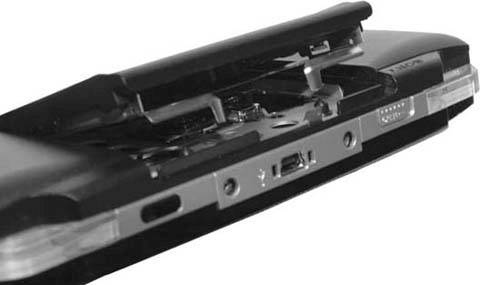 1.7.2. Can't Read the Memory StickIf your PSP isn't recognizing your Memory Stick Duo card, first try removing the card and then replacing it, just to make sure it is firmly seated and properly inserted into the PSP. 1.7.2.1. Check the physical parts.If it still isn't registering, remove the card again and take a look at the contacts of the card (see Figure 1-19). Some slight abrasion is to be expected, but if there is any dirt here, clean it off. Figure 1-19. The little metal contacts on the Memory Stick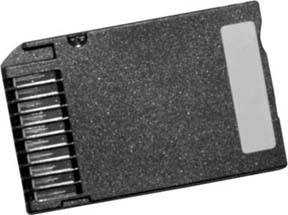 If the contacts look smudged or there is any sort of dirt on them, take a soft cloth and clean them off. Also, in Figure 1-19, you will notice that there are some slight abrasions on the card. This is to be expected. However, if there is major scarring, your card might be beyond hope. To prevent major scarring of the card, keep it in some sort of case when it is not in use and try not to swap it in and out too often. Over time, these contacts will eventually fail, so make sure you back up your data often [Hack #2]. If the card was dirty, but you've cleaned its contacts and it still isn't reading properly, check inside the card slot. Make sure that there is nothing sticking in the slot that shouldn't be there, and if the area around the slot looks dirty, hold the cover open as in Figure 1-20, turn the PSP on its other end, and shake gently to try to free any debris. Remember: a can of compressed air is your friend. Blow a gust of air down the slot to try to free up anything that your card might have smashed in there, and then turn the PSP on its end and shake again. Figure 1-20. Taking a peek in the Memory Stick card slot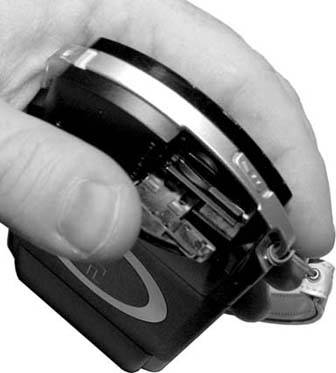 1.7.2.2. Check the data.If you have a Memory Stick Duo compatible card reader, try hooking the Memory Stick up to your computer. If it doesn't show up at all on your computer either, then it looks like the card is probably dead. Time to buy a new one. If it does show up, check to see whether the data looks right. Make a backup of the data (separate from any previous backups you may have on file) and reformat the card. Now put the card back into the PSP and see whether it shows up. If the Memory Stick shows up but doesn't seem to be behaving properly, or if it still isn't showing up, navigate to Settings Figure 1-21. If all else fails, try selecting Format Memory Stick from the System Settings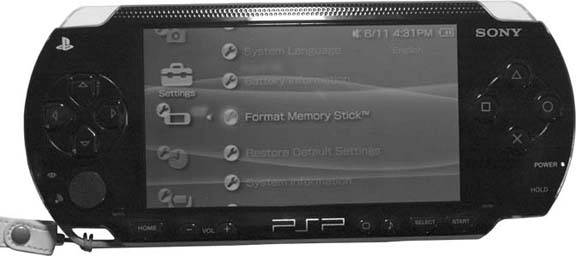 If it still fails to show up, or if the PSP gives you an error saying there is no Memory Stick to format, then either your card is dead or your PSP's Memory Stick slot is damaged. Try another card (borrow one from a friend if you don't have one on hand) in the slot. If this second card shows up, then your card is deadgo buy a new one. If it doesn't show up, it's time to get your PSP repaired. 1.7.3. PSP Won't Turn OnIf your PSP won't turn on, then of course you are going to want to check the power. Maybe your battery has been fully depleted. Plug in the AC adapter and watch to see whether the power indicator light has turned orange to indicate charging. If yes, check to see whether the PSP will now turn on. If so, then your battery was simply discharged. If the power indicator light did not turn on and turn orange when you plugged in the PSP, then see whether you can turn the PSP on. If so, look on the upper-right corner of the screen. Is the battery indicator showing up? If so, perhaps your battery was simply discharged and is now charging, but for some reason the charging indicator light didn't turn on. Unplug the unit and see whether it stays powered. If it shuts down, then there is most likely something wrong with the unit or your battery. Likewise, if the PSP still isn't turning on, then there is quite possibly something wrong with the unit or the internal battery. Open up the battery compartment on the back of your unit. Remove the battery and check the contacts to make sure they are clean, as shown in Figure 1-22. Reinsert the battery and try repeating the above steps. If everything still fails to work, ask one of your friends to lend you her battery so you can test to see whether it is the battery or your PSP. If your PSP powers up with your friend's battery, there is something wrong with your battery and you should get a replacement. If your PSP does not power up on your friend's battery, there is something wrong with your PSP and you need to have it serviced.
Figure 1-22. Open up the battery compartment and make sure that the contacts on both the battery and the PSP are clean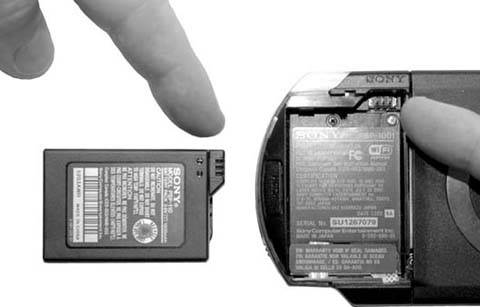 1.7.4. Miscellaneous ProblemsHere's a short list of other problems and their possible solutions:
If all seems lost, and you cannot seem to solve whatever problem has befallen your PSP, don't despair. Check out "Repurpose a Dead PSP" [Hack #10] for some pointers on trying to recoup some of the money from your PSP toward a purchase of a replacement PSP. 1.7.5. Hacking the HackOf course, if you run through all these troubleshooting tips and things still aren't working, youas a would-be hackerare left with an entirely new set of choices:
If you chose #3, then you are definitely reading the right book. Head on over to "Take Your PSP Apart" [Hack #8] for some help in finding your way through the maze of your PSP's electronic innards. If your hacking and attempted repair job doesn't work, you can always try some of the options discussed in "Repurpose a Dead PSP" [Hack #10]. |
EAN: 2147483647
Pages: 108
- Chapter III Two Models of Online Patronage: Why Do Consumers Shop on the Internet?
- Chapter IV How Consumers Think About Interactive Aspects of Web Advertising
- Chapter XIII Shopping Agent Web Sites: A Comparative Shopping Environment
- Chapter XIV Product Catalog and Shopping Cart Effective Design
- Chapter XV Customer Trust in Online Commerce

 System Settings and hit the X button. Select Format Memory Stick (see Figure 1-21) from the list of settings and hit the X button. The PSP will ask you twice whether you are sure you want to format the Memory Stick. Select Yes and hit X, then select Yes again and hit X again. This will erase all of the data on the Memory Stick.
System Settings and hit the X button. Select Format Memory Stick (see Figure 1-21) from the list of settings and hit the X button. The PSP will ask you twice whether you are sure you want to format the Memory Stick. Select Yes and hit X, then select Yes again and hit X again. This will erase all of the data on the Memory Stick.